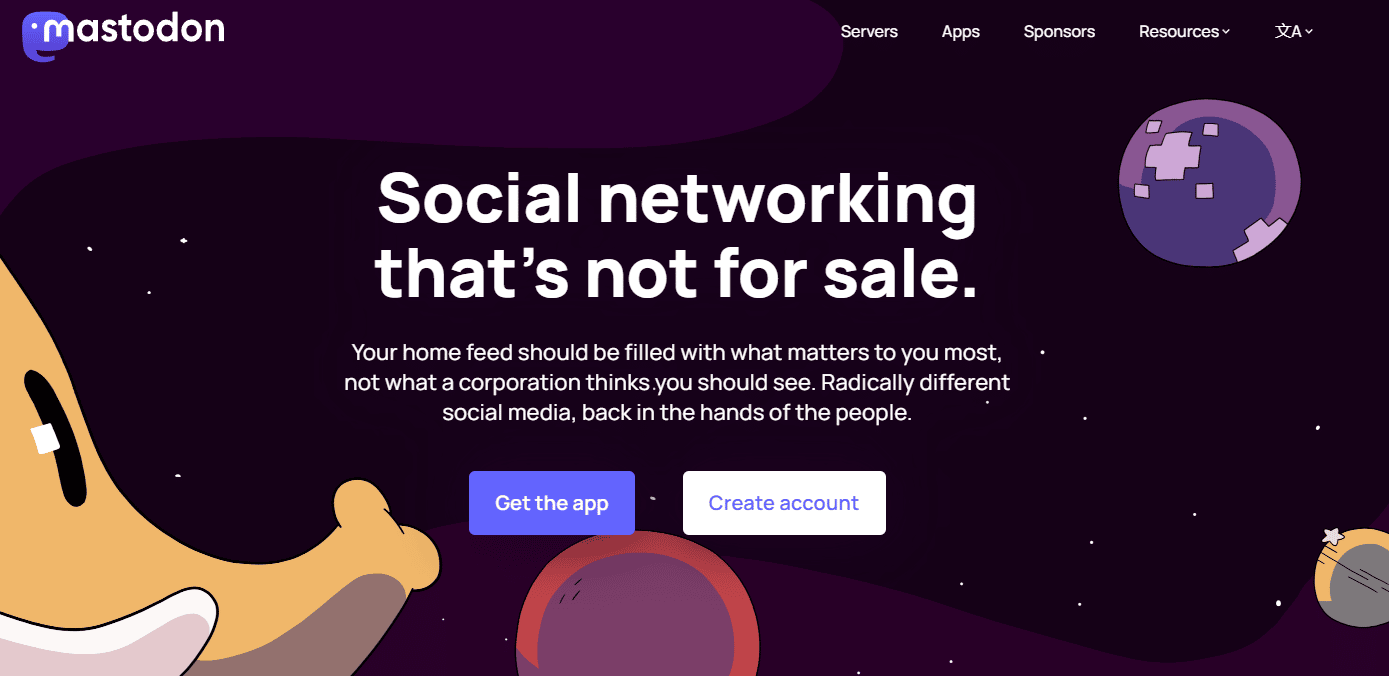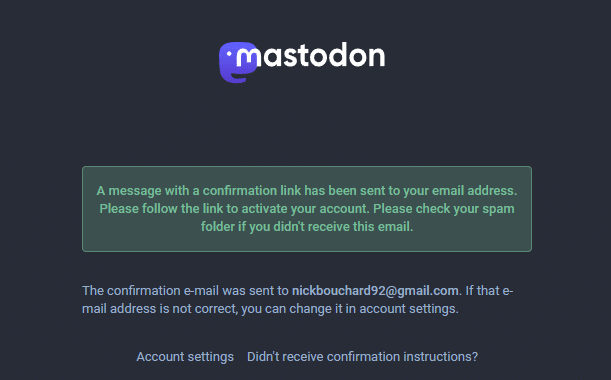You’ve seen the name pop up again and again on Twitter: Mastodon. Usually, it’s from people making grand claims about Twitter’s future and declaring that they’re leaving the app.
Next to the name is a URL, a slightly different profile picture, and maybe a screenshot of a platform you’ve never seen before. You’ve been racking your brain trying to figure out what Mastodon is, how it works, and whether you should be on it, too.
If you’re a marketer, maybe you’ve been wondering if there’s a way you can monetize this trend. It’s okay, we know you thought it. We won’t tell anyone.
Let’s dive into Mastodon. We’ll explore why everyone’s interested in it, and whether it can actually replace Twitter. We’ll also help you figure out whether there’s any marketing potential on this newly trending alternative social media platform.
What is Mastodon?
Mastodon is a decentralized social network made up of independent servers organized around specific themes, topics, or interests.
People can join servers, follow each other, engage in conversations, and otherwise do all sorts of things they’d expect to do on a social network like Twitter.
Mastodon has been around since March 2016 but it only really blew up in late 2022, when a certain someone bought a certain social media platform.
Why? Mostly because a ton of people on Twitter have said they’re leaving the platform for Mastodon.
While the posts you’ve seen about Mastodon on Twitter recently might make it seem like it’s just a copycat alternative, Mastodon is actually completely different from the blue bird app. Let’s see just how different.
How does Mastodon work?
The biggest difference between Mastodon and Twitter can be summed up in a single word: decentralization.
Social media platforms like Twitter are centralized, meaning they’re owned and operated by a single company. That company builds features, moderates content, tweaks algorithms, and handles all other tasks that come with running a social network.
Comparatively, while there are people at a non-profit company called Mastodon gGmbH that work on the social platform known as Mastodon — stick with us here — the platform itself isn’t centralized within that company. That’s because it’s made up of thousands of independent servers.
Think of a Mastodon server as a mini social network or a forum. Usually, a server is organized around a specific interest, topic, or industry. Once you’ve joined a server, you can follow, reply to, and engage with anyone on Mastodon, no matter what server they’re on.
But what can you do on Mastodon exactly? The short answer: a lot of the same things you can do on Twitter. You can talk about what’s on your mind, contribute to conversations that pop up in your feed, post pictures of your cats, and so on. You get your feed, where you’ll see posts from the people you follow, and an explore tab that lets you find new interesting folks.
You’ll see some differences, of course. For example, you can’t start a thread the way you do on Twitter, but you can reply to yourself and essentially replicate a Twitter thread. You’ll also need to pick a server to host your account.
The biggest servers are general, meaning they have no specific topic — these will feel more similar to Twitter. But you’ll also find that tech topics, like Bitcoin and software development, have some of the most popular servers. You can use a platform like mastodonservers.net to find the server you want to join.

And if you’re looking to find the Mastodon equivalent of the Twitter accounts you follow, you can use Debirdify to find them automatically.
How can businesses use Mastodon?
If you’re looking to Mastodon as the social network of choice for the initiatives you’ve been running on Twitter until now, you might be disappointed.
Because it’s a network of servers, rather than a single social platform, businesses can’t go through a single person or platform to “do marketing” on Mastodon. Additionally, Mastodon’s homepage states that the service will never serve ads or push some profiles above others. Since Mastodon is run by a non-profit, there’s no profit incentive and no desire to work with advertisers.
That said, there are still ways for businesses to take advantage of this surge of interest in Mastodon.
Market research
In this facet of advertising, Mastodon might be a great alternative to Twitter. That’s because while Twitter lets you search hashtags and topics, you’re still served an uncategorized mess of Tweets in an order that’s not particularly useful to you — thanks to the algorithm.
But with Mastodon, each server is essentially a self-contained community gathered around a single topic, whether that’s locality, a shared interest, or even a specific career.
Find the right server, and you can get unfiltered access to what really matters for your target demographic or a new market segment.
Affiliate marketing, sponsorships, and UGC
You could absolutely run affiliate marketing, sponsorship, and UGC campaigns through Mastodon. You could try reaching out to individual accounts with a certain number of followers the same way you would on another platform; you might just have to do a bit more digging before you find the right accounts.
Keep in mind that follower counts are generally much lower on Mastodon than on Twitter, meaning your efforts might not be as effective. For example, George Takei has 3.1 million followers on Twitter and only 235,000 on Mastodon. You might struggle to find influencers of the same size you’re used to working with.
Advertising
This one will be a bit harder to pull off. The people behind Mastodon are staunchly anti-advertisement, meaning that there’s no infrastructure for pushing ads broadly on multiple servers.
That said, each server operates completely independently, so there’s nothing stopping a server owner from putting in their own infrastructure to accept payments, meaning technically servers can sell ad space.
But if you try advertising on Mastodon, you might run into some resistance. Mastodon users expect to see fewer ads — if any at all.
Create your own community
You might not be able to run ads, and you might not find the next big influencer, but you know what you can do on Mastodon? Run your own server.
Sure, it’s a bit more technically involved than starting a YouTube channel or running a Twitter account, but having your own Mastodon server comes with one big advantage. You have complete control over it. That means you can choose to approve every new account, you can handle content moderation, and you can steer the conversation. That can make it a powerful marketing tool.
Community outreach
Because Mastodon doesn’t have an algorithm pushing certain posts over others, you can’t just post and hope for the best. You have to go out of your way to engage with the community if you want to get any traction.
But because Mastodon is organized in servers, you don’t have to go searching through the void to find your customers — both current and potential.
Running a SaaS business? Find servers where people talk about SaaS to answer questions, offer your knowledge, and become a trusted expert. Work in art supplies? Go to servers where artists hang out and join the conversation.
Become an expert in an underserved topic
Currently, Mastodon has over 8,000 servers, but does it have one for your niche? Searching up “SaaS” on mastodonservers.net returns a single server with just over 20 users. A search for “marketing” only finds one server, too.
You see the opportunity, right?
Create your own server, pick a topic that fits your niche, and start creating content. You can even repurpose content from your blog, your YouTube channel, or your website to get started.
How to create a Mastodon account
1. Go to joinmastodon.org
Click Create an account.

Then, scroll down until you see a list of servers.

2. Pick a server
Then, hit Create account (again).

3. Create an account
On the server page, click Create account in the panel on the right side of the screen.

Then, Review the rules of the server and hit Accept.

Once that’s done, fill out the signup form, check the privacy policy box, and click the Sign Up button.

4. Confirm your email address
You will receive a confirmation email. Follow the link in the email to activate your account.

Congratulations! You’ve just signed up for Mastodon. You’ll be taken to your home screen, within the server you chose to join. From here, you can start following people — no matter which server they’re on — to get posts in your feed, explore popular content from other servers, and more.

Note that you’re not stuck in that server just because that’s where you created your account. If you want to choose a different server to serve as your account’s home base, you can migrate your account between servers.
Can Mastodon replace Twitter?
That depends.
While Mastodon has seen a huge surge of popularity recently — going from 1 million monthly active users to 2.5 million in about a month — that doesn’t even put it in the same ballpark as Twitter.
Twitter has just crossed 250 million monthly active users for the first time, according to this Tweet from CEO Elon Musk:
So despite the concerns that havebeen surrounding Elon Musk’s takeover, Twitter doesn’t seem to be in any true danger. At least not yet.
For Mastodon to have a chance to replace Twitter, it needs to either provide a similar enough experience to Twitter or something that’s significantly better.
So the true question is can Mastodon do that?
Well first, the people behind the platform would need to want to do that, and that doesn’t seem to be the case. They’re not trying to build a better Twitter, they’re building something that’s almost a sort of anti-Twitter:
“Mastodon is free and open-source. It has no ads, respects your privacy, and allows people/communities to self-govern. This is because at Mastodon, we present a vision of social media that cannot be bought and owned by any billionaire, and strive to create a more resilient global platform without profit incentives.”
The key differences between Mastodon and Twitter — profit vs. non-profit, centralized vs. federated — make it difficult to say whether Twitter can get replaced. Many Twitter users seem to think that’s the case right now, but the platforms are so different that it’s doubtful Mastodon will be a lasting replacement.
Especially since most people who said they were leaving Twitter for Mastodon haven’t really left.
That said, it’s likely that several ex-Twitter users will find Mastodon’s decentralized network model preferable to Twitter, and the change will stick. But the average user will probably stick with the the platform they know — unless a more direct challenger emerges.
Mastodon FAQ
Still have burning questions? We have the answers.
What is Mastodon social media?
Mastodon is a social platform that’s exploded in popularity following Elon Musk’s takeover of Twitter, with many Twitter users jumping to the platform. While it’s been around for six years, its monthly active users more than doubled at the end of 2022.
Who owns Mastodon social media?
Mastodon was developed by Mastodon gGmbH, a non-profit company from Germany. But since the social media platform is both open-source and decentralized, there’s no single “owner.” Instead, individual Mastodon servers — essentially self-contained communities — each have their own owners.
How is Mastodon different from Twitter?
Instead of being a single, centralized place where everyone Tweets, replies, and throws shade, Mastodon is a decentralized network of individual servers. Each server is organized around a specific topic, company, or interest, and a server’s members can interact with members of other servers.
Additionally, because Mastodon is run by a non-profit, is has no advertising infrastructure, no built-in monetization, and no algorithms.
How do you find people on Mastodon?
If you’re looking for a specific person, you can type in their name or URL (their account’s unique identifier) in a search bar right above your profile picture. Just looking for new accounts to follow? Then you’ll want to hit the #Explore tab to the right of your home screen.







